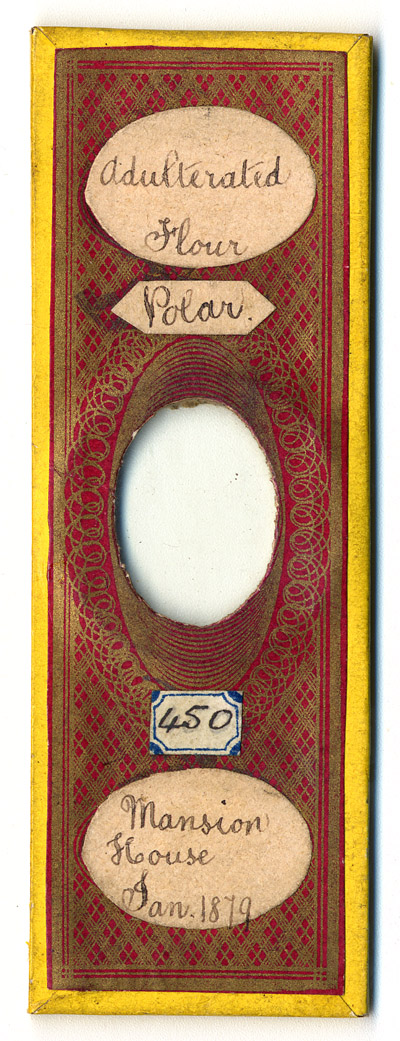
Figure 1. This microscope slide was probably prepared by Alfred L. Corbett, who presented a slide of “flour adulterated with plaster of Paris” at the February 14, 1879 Conversational Meeting of the Quekett Microscopical Club.
Adulterated Flour, London, January, 1879
by Brian Stevenson
last updated April, 2014
The microscope slide shown in Figure 1 preserves evidence from a legal case that helped bring about changes in English food safety laws, which likely also impacted on public health in other countries. A large shipment of “flour”, composed primarily of gypsum, was imported into England in late 1878. London’s Medical Officer for Health, William Sedgwick Saunders, managed to track down the dangerous substance the following January, and tried to have it confiscated as a health threat. What followed in a court of law was apparently legally correct, but morally questionable. At that time, selling of adulterated food was frequently considered to be fraud against the buyer, rather than a public health hazard. Moreover, interpretation of laws often favored the seller, who could claim that the substance was not intended to be used as food, or the contaminant was added without the seller’s knowledge.

Figure 1.
This microscope slide was probably prepared by
Alfred L. Corbett, who presented a slide of “flour adulterated with plaster of
Paris” at the February 14, 1879 Conversational Meeting of the Quekett
Microscopical Club.
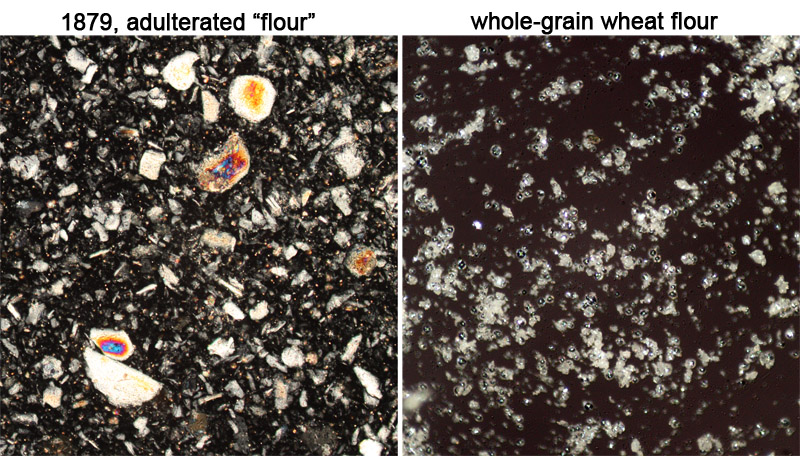
Figure 2.
Views of the 1879 “flour” and modern whole wheat
flour, both viewed at the same magnification (10x objective), using crossed
polarizing filters. Starch in wheat flour shows refraction of white light. The
minerals in the 1879 sample exhibit colorful refraction. The mineral-laden 1879
sample also shows many sharp fragments, as opposed to the more rounded pieces
of actual crushed wheat seed shown on the right. Referring to the adulterated
“flour”, the satirical magazine ‘Punch’ declared that a baker “may think
himself warranted in bringing these loaves into the market as ‘French bread’,
on the strength of the Plaster of Paris they contain”.
The story of the “flour” was reported in both The Medical Times and Gazette and The Sanitary Record. A composite of their stories follows:
The Medical Times: “Much objection must be taken to the action - or, to speak more correctly, the want of action - of the Lord Mayor in a case of food adulteration brought before him last week.
The Sanitary Record:, “Dr. (William) Sedgwick Saunders, medical officer of health for the City, applied to the Lord Mayor for an order for the condemnation of seventy-nine sacks of flour which was unfit for human food. Dr. Saunders said the application was made under the 2nd section of the Nuisances Removal Act 1863, that the Lord Mayor would give an order preventing the consumption as human food of seventy-nine bags of stuff which was called flour, and which had been imported as meal, and had been sold as such. This meal he had ascertained by analysis consisted of seventy-nine per cent, of sulphurate of lime or plaster of Paris.
As far back as September last the sanitary inspector of the district received information that 100 sacks of this meal had been imported by a member of what was called the Long Firm who had been endeavouring, by giving sampling orders and otherwise, to sell the stuff as meal or flour. At that time he (Dr. Saunders) was unable to get a sampling order, as he was unable to find the consignees, Jackson and Co. The flour came by the Baron Osy from Antwerp, in August last, and, failing to get the sampling order, he made application for the condemnation of the stuff, but he was advised that unless he positively obtained a sample and analysed it the authority he required could not be obtained. The thing, therefore, remained in abeyance until Mr. Alexander, manager of the Belgian Bank, Lombard Street, applied to him privately to analyse some of this very flour, upon which he had advanced 30£. Through Mr. Alexander he obtained a sampling order in connection with eighty sacks of flour described as meal.
The Lord Mayor: Why does Mr. Alexander not prosecute?
Dr. Saunders: That is not a question for me.
The Lord Mayor: But it is a very pertinent one for me to consider.
Dr. Saunders: I am acting simply as the guardian of the public health. In the meantime, and while the ulterior proceedings are pending, this stuff may be sold; in fact, I am informed that it has already been sold to a French baker. I would ask your lordship to put your veto, and say it shall not be removed.
The Lord Mayor: No; I cannot put my veto on it at all. The first step is for the person who has been taken in to proceed by summons or warrant against those who have taken him in, for obtaining advances by false pretences. I must see if I cannot punish the party for importing such stuff. Besides, I have no proof that this was sold as flour. The party may come here and say that he has not offered it as flour, and that he does not intend to sell it as such.
Dr. Saunders said he had already seized the stuff.
The Lord Mayor: Then let the party who has been deceived come forward and prosecute.
Dr. Saunders: I have no power to deal with the stuff until your lordship condemns it. It is not fit for human food.
The Lord Mayor: I do not know that it has been offered as food.
Dr. Saunders: That is the difficulty.
The Lord Mayor: With all due respect to the position you hold, Dr. Saunders, I am bound to protect the public here. The first step is to bring forward evidence of the party disposing of the flour.
Dr. Saunders: With all respect I submit that I have nothing to do with Mr. Alexander or anyone else.
The Lord Mayor: I have nothing further to say. That is my decision.”
Editor’s Note from The Sanitary Record: “It is somewhat difficult to disentangle this case. The decision of the Lord Mayor has been severely commented on, but was the matter rightly brought before him? It does not appear from the report to whom the flour belonged, or who was the party charged, who in the terms of the 2nd section of the Nuisances Removal Act 1863, has the burden cast upon him of 'the proof that the same' (that is the flour) 'was not exposed or deposited' for the purpose of sale or preparation for sale, and intended for the food of man.' It appears to us that the case was not properly before the Lord Mayor in order to secure a conviction, and to obtain an order for the destruction of the flour. We hope in a matter of so much importance that Dr. Saunders will again bring the matter into court, supported by proper evidence”.
The Medical Record and Gazette continued, “the Lord Mayor saw fit to insist that the person who had advanced a sum against the adulterated flour should come into court and prosecute the importers for obtaining money under false pretences. .. (He) declined to grant the order sought for by Dr. Saunders, who was accordingly compelled to leave the court without the order he had applied for. Meanwhile the importers will have ample opportunity afforded them for disposing of this adulterated article; and the inhabitants of one of the poorer districts of the metropolis will suffer in proportion, thanks to the delicate point of law propounded by the chief magistrate of the City of London”.
Sedgwick Saunders apparently persevered, as the January 24 issue of The Sanitary Record reported, “B. Dunkel Buhler, Hop Exchange, and Carl Steitz, Little Trinity Lane, have been charged at the Mansion House Police Court with conspiring to obtain 27£. 14s. 6d. by false pretences, in knowingly representing a certain material to be flour which was not flour at all. In this case, which sprung out of the adulterated flour case on which we commented in the Sanitary Record of Jan. 17, page 45, the summonses were adjourned, the Lord Mayor allowing the defendants bail in one surety of 100£. and themselves in 200£.”
However, The Medical Times and Gazette reported in April, “The City ‘adulterated flour’ case, originally ventilated by Dr. Sedgwick Saunders, has, after several weeks, at length been settled. The defendants, two Germans, were on Saturday brought up at the Central Criminal Court to answer the charge of endeavouring to defraud Mr. Alexander, of the Anglo-Belgian Bank, by falsely pretending that eighty sacks of plaster of Paris contained flour or meal; and for unlawfully attempting to pass off the contents as fit for human food, whereas they were noxious and poisonous matter. The evidence adduced proved that the prisoners had themselves been imposed upon, and the jury, adopting this view, immediately returned a verdict of ‘Not guilty’. The Recorder expressed his opinion that a gross fraud had been perpetrated by the original consignor of the article, and the jury concurred, adding that they did not think the defendants were in any way concerned in it. Although the inquiry has failed to bring to light the principal culprits, it will be admitted that Dr. Saunders was perfectly right in protecting the public by the vigorous proceedings he sought to institute at the outset of the case”.
The January 25 issue of Punch described the case of “Flour v. Gypsum”: “That most far-sighted of Lord Mayors, the illustrious Whetham, seems to be as determined on damping sanitary zeal as over-eager charity. Only in this way can we explain the snubbing he thought fit to administer to Dr. Saunders, Officer of Health and Public Analyst for the City, who had been ill-advised enough to bring before him the case of a cargo of stuff imported as wheat-meal, but so largely adulterated with Plaster of Paris, that Dr. Saunders was able to exhibit a donkey's head moulded from this devil's dust, in practical illustration of the quality of the samples from twenty sacks, armed with which he sought the aid of the Lord Mayor to have the perilous stuff condemned and seized before it found its way into the trade, the bakers' ovens, and the stomachs of Her Majesty's lieges.
The Lord Mayor, instead of condemning the villanous mixture, condemned the doctor, telling him he should have prosecuted the man who sold the flour. The usual course of common-place Magistrates acting under the power of the Nuisance Removal Act applicable in such matters, is to direct seizure of the offending article, and so keep it out of the market. The Lord Mayor prefers to wait till it gets there.
In the mean time, Dr. Saunders has learnt that a foreign baker in Dean Street, Soho, has made 114 "wheaten loaves" from this gypsumised meal, two of which were laid on the table besides the ass's head - the bane beside the symbol of what should have been the antidote.
Probably the foreign baker may think himself warranted in bringing these loaves into the market as ‘French bread’, on the strength of the Plaster of Paris they contain. We should like to see the illustrious Whetham condemned to a week of this costive semicereal mixture, by which time he would, perhaps, be brought to understand that it is better to keep such a poisonous compound out of the market, than to take your chance of tracing it into so-called bread-stuffs, after it gets there”.
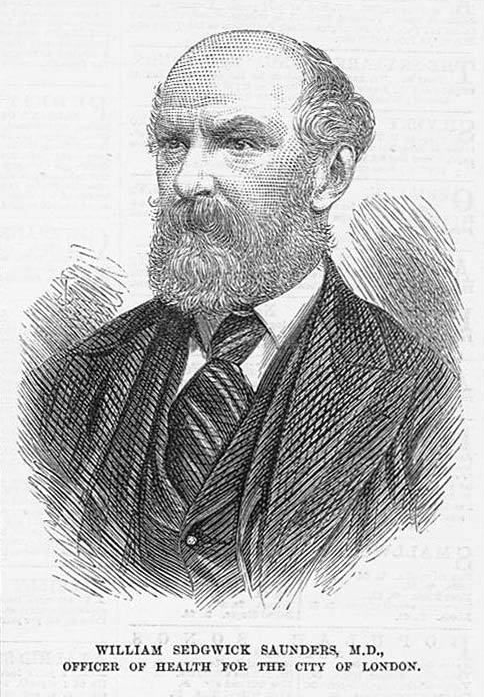
Figure 3.
Dr. William Sedgwick Saunders (1824-1901). He served the City of London
as Medical Officer for Health from 1874 until his death. He implemented
numerous public health improvements in the city, including sewage and garbage
disposal and combating diseases such as cholera. He was also involved with investigation of the Jack the Ripper cases. Engraving from The Illustrated
London News, 1874.
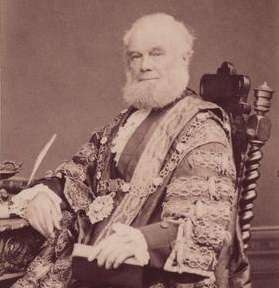
Figure 4.
Sir Charles Whetham (1812 -1885), Lord Mayor of London from 1878-1879.
This photograph presumably dates from his mayoral term.
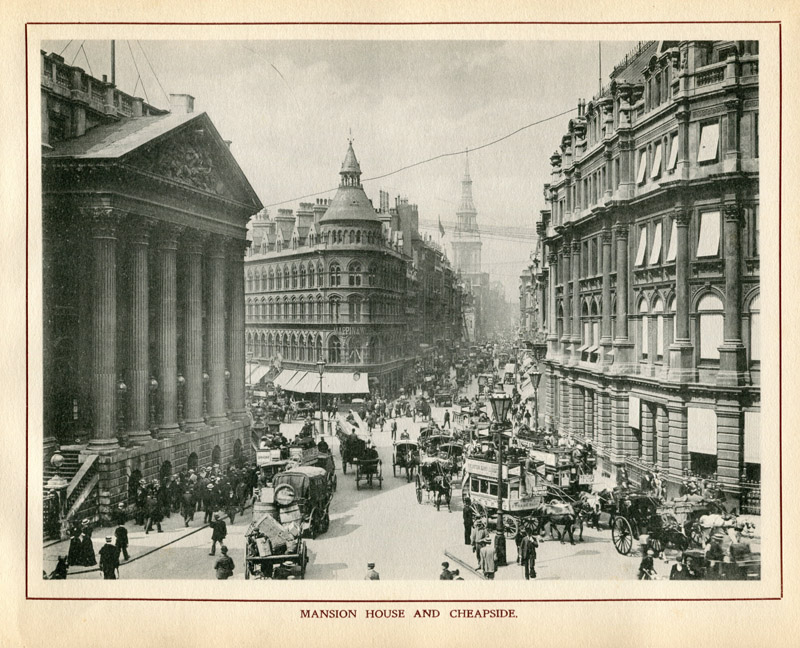
Figure 5.
The Mansion House (on the left) is the Lord Mayor’s
house and served as an office and court building. Photograph circa 1900.
Resources
The Album of Photographic Views of London (1902) London Stereoscopic and Photographic Company, London
British Medical Journal (1901) Obituary - William Sedgwick Saunders, LRCP Edin., MRCS, FIC, Jan. 26, pages 248-249
Chemical News (1875) The probable working of the new act as compared with the old, Vol. 31, pages 258-260
Illustrated London News (1874) The City Medical Office of Health, Vol. 65, July 18, pages 59 and 61
Journal of the Quekett Microscopical Club (1879) February 14, 1879 Conversational Meeting, Vol. 5, page 194
The Lancet (1881) The dispisal of refuse, Vol. 1, page 929
Medical Times and Gazette (1879) The week - topics of the day, Vol. 1, Jan. 18, pages 68-69
Medical Times and Gazette (1879) The week - topics of the day, Vol. 1, April 12, page 404
Punch (1879) Flour v. Gypsum, Jan. 25, page 25
The Sanitary Record (1879) Adulteration of flour, Vol. 10, Jan. 17, page 45
The Sanitary Record (1879) Adulterated flour, Vol. 10, Jan. 24, page 60
Sedgwick Saunders, William (1866) Report to the Board of Guardians of the City of London Union: And to the Special Committee Appointed Under the Direction of the Privy Council, on the Causes and Prevention of Cholera, Truscott & Simmons, London
Sedgwick Saunders, William (1867) Sketches from the History of Medicine: Ancient and Modern, Hunterian Society, London